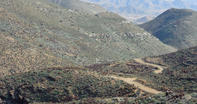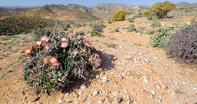Who Were the Trekboers?
And who were the trekboers? Well, initially, all European farmers were obliged to live within a short distance from the Fort at Cape Town, so that the ubiquitous Company could keep an eye on them.

By the early 1700s, however, the settlement had outgrown its suppliers and additional lands were required to meet the demand for food and meat. The white farmers were thus allowed to ride out and claim new lands over the mountains. This was the advent of the Trekboers (literally, travelling farmers) and these hardy Europeans proceeded to usurp territory all over the Cape.
Later, this land grab was formalised into a system of loan farms, which allowed farmers to claim huge chunks of territory in exchange for a low annual rent to the Company. Indigenous land rights were, of course, ignored. Even the semi-respectable Bastaards were forced to give up their lands when confronted with a white farmer’s claim.
White Expansion
And so, the trekboers started spreading out, first into the fertile Overberg in the east and then into the land of Waveren in the north-east. Although Namaqualand, with its arid climate, was not initially affected by this white expansion, many Khoikhoi and Bastaard groups were pushed out of their lands by the trekboers and moved north.
This put additional pressure on the land and political integrity of the Namaqua. Soon, the trekboers and Dutch authorities at the Cape also became involved in nominating and appointing Khoikhoi chiefs, even awarding them with a copper-headed ‘staff of office’ in exchange for their collaboration and support in trading ventures.
This further undermined the Khoikhoi’s traditional hierarchies. Then, in the 1750s, the first trekboers started entering Namaqualand where they claimed vast farms for themselves.
Land Competition

In practice, these European farmers were not very different from the indigenous nomadic farmers who had previously worked the land. In the arid Namaqualand region, for example, most of them adopted the traditional matjieshuise as their housing unit of choice.
They also migrated with their animals, moving with the seasons to seek out the best grazing land. Obviously, this put them in direct competition with the Namaqua herders over the scarce natural resources.
However, the European farmers had God and the government on their side and, with their western concept of private land ownership firmly in place, they inexorably took over the countryside. Accordingly, over the next 100 years, the trekboers effectively marginalised the native Namaqua from their ancient pasturage.
The Namaqua, Bushmen, Khoikhoi refugees and Bastaards were subsequently pushed further and further into the north, where they found themselves competing with one another. The transhumance that had once defined their lives was being constrained and their traditional migration patterns were shattered.
Some capitulated and became servants of the trekboers, or took up work as labourers on their farms.
Native Reserves
Others retreated to the relative safety of the mission stations or into remote places of refuge that came to be called ‘native reserves’, most notably around the Leliefontein mission in the Kamiesberg and in the Richtersveld (which, until 1847, was beyond the official borders of the Cape Colony).
Today, these communal areas comprise 25% of Namaqualand and contain 40% of its population. Some groups even turned renegade and started raiding the kraals and villages of their neighbours. Indeed, the whole Orange River frontier became something of a ‘wild west’ during this period, with dozens of robber bands of various racial compositions roaming the area, causing trouble.
One particularly unpleasant incident that lingers in the collective memory of Namaqualand took place in the mid-1800s, when a severe drought gripped the area. As a result, the people at the mission station of Steinkopf moved their families and herds to a small spring about 15 km away.
Then, one Sunday while the adults were at church, a group of marauding Bushmen invaded the camp, killing 32 Nama children. This site is marked by a simple tombstone and is known, simply, as Kinderlê (where the children lay).